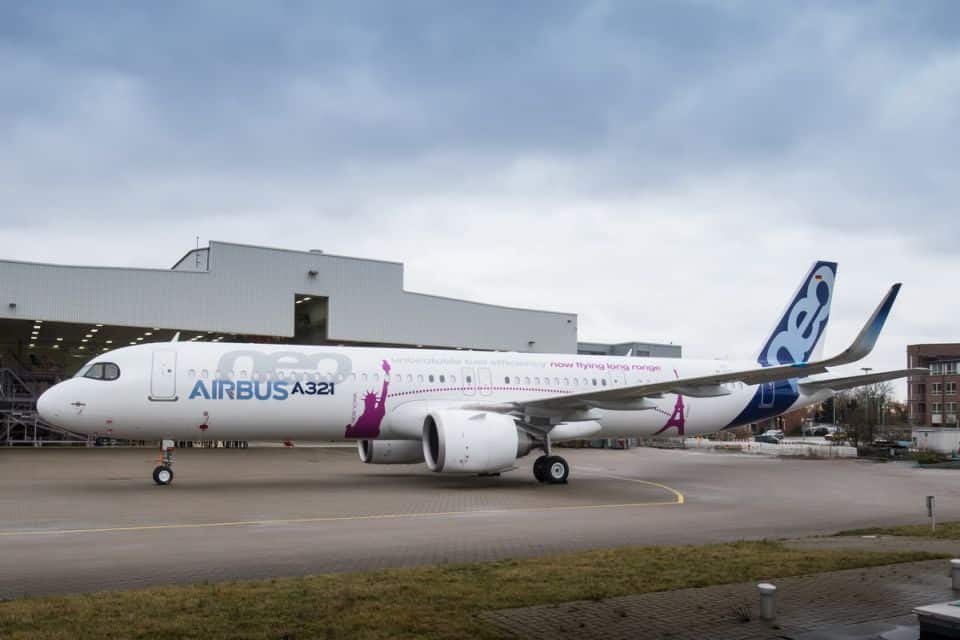Aerospace
Airbus starts A321 aircraft production in China’s Tianjin
Airbus starts A321 aircraft production in China’s Tianjin

At its Final Assembly Line Asia (FALA) facility in Tianjin, north China, the European aircraft manufacturer Airbus began producing A321 aircraft on Wednesday, demonstrating that China is capable of supplying all models of Airbus’ A320 family of aircraft.
Airbus and partners embark on SAF deliveries in China(Opens in a new browser tab)
Early next year is anticipated for delivery of the first A321 built in Tianjin. As of right now, the company’s backlog of A321 aircraft makes up about 60% of its whole global backlog for the A320 series of aircraft. The single-aisle A321 variant can carry more than 200 passengers and can travel long distances with the same capacity as a wide-bodied aircraft, but at less expensive operating costs.
China’s 14th Five-Year Plan (2021–25) projects that by 2025, the nation’s civil aviation industry will transport 930 million passengers and 9.5 million tonnes of cargo and packages annually. By 2025, there will be more than 70 countries and regions connected to China by air, and more than 50 of them will be partners in the Belt and Road Initiative.
Three missions, one aircraft: Airbus A400M shows its potential in the UK(Opens in a new browser tab)
By beginning A321 production, Airbus has conveyed encouraging messages to China, according to Zhang Yi, an associate professor at the Economic and Management College of the Civil Aviation University of China. Zhang said he thinks it demonstrates the assurance and optimism of Airbus and other European businesses on the swift recovery and expansion of Asia’s aviation sector.
Despite having a big population, China’s aviation sector has significant potential because the number of yearly air passenger flights per person in the nation is less than 0.5, compared to a rate of about 2.5 for developed nations.
Over the next two decades, China will continue to be the world’s largest market for new aircraft. “Of the nearly 4,000 commercial aircraft in the Chinese market, 2,100 Airbus aircraft account for more than 50% of the total,” added Xu. According to him, Airbus’ growth in China has been made possible by the country’s civil aviation industry chain’s development.

Aerospace
Boeing Transfers Rocket Stage to NASA, Paving Way for Human Moon Mission

Boeing has achieved a significant milestone by providing NASA with the second core stage of the Space Launch System (SLS) rocket.
This crucial component, crafted at NASA’s Michoud Assembly Facility (MAF), is set to propel the Artemis II crew into lunar orbit, marking humanity’s return to deep space after a 50-year hiatus.
The monumental Boeing-built rocket stage, the largest element of the Artemis II mission, will embark on a journey aboard the Pegasus barge, traveling 900 miles to NASA’s Kennedy Space Center.
Comparison of two legendary aircraft B777x vs B747 aircraft:Click here
Upon arrival, it will be meticulously integrated with other essential Artemis II components, including the upper stage, solid rocket boosters, and NASA’s Orion spacecraft within the iconic Vehicle Assembly Building. This intricate integration process is a vital step toward the eagerly anticipated Artemis II launch, slated for 2025.
“Boeing-built products helped land humankind on the moon in 1969, and we’re proud to continue that legacy through the Artemis generation,” remarked Dave Dutcher, vice president and program manager for Boeing’s SLS program. “Together, with NASA and our industry partners and suppliers, we are building the world’s most capable rocket and paving the way to deep space through America’s rocket factory in New Orleans.”
NASA, Lockheed Martin Reveal X-59 Quiet Supersonic Aircraft:Click here
The delivery of Core Stage 2 marks a significant achievement in the evolution of the SLS rocket. Towering over 200 feet and powered by four RS-25 engines, this core stage, coupled with two solid-fueled booster rockets, will generate a staggering 8.8 million pounds of thrust. This immense power is crucial to launching Artemis II and future missions into the vast expanse of space.
The SLS rocket stands unparalleled in its capability to transport both crew and substantial cargo to the moon and beyond in a single launch. Its extraordinary capacity will facilitate the delivery of human-rated spacecraft, habitats, and scientific missions to destinations including the moon and Mars, ushering in a new era of space exploration.
-

 Travel1 week ago
Travel1 week agoAir India to Expand US Operations with Three New Routes After a Decade
-

 Travel2 weeks ago
Travel2 weeks agoWhy We Should Avoid These Stamps in a Passport
-

 Airlines1 month ago
Airlines1 month agoInvestigations Reveal Fake Chinese Titanium in Boeing and Airbus Jets
-

 Tech4 weeks ago
Tech4 weeks agoChina’s CATL Plans 1,800-Mile Electric Plane Launch by 2027
-

 Airport3 days ago
Airport3 days agoTop 10 Largest Airports in the World by Size
-

 Aerospace4 weeks ago
Aerospace4 weeks agoChina’s Fighter Jets Turn Wings into Autonomous Drones
-

 Airlines4 days ago
Airlines4 days agoAir India Rolls Out A350s for Delhi-New York JFK and Newark Routes
-

 Defence3 weeks ago
Defence3 weeks agoBoeing Enhances Chinook with New Engines and Block II Upgrades at $96 Million







